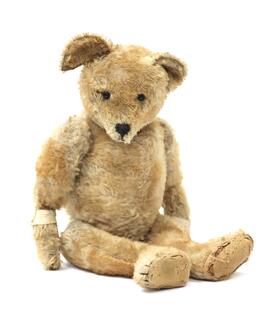Which Bear Goes There? Teddy Bear Identification
Which Bear Goes There? Teddy Bear Identification
The humble teddy bear is synonymous with childhood and most children will have fond memories of some form of cuddly toy growing up. In terms of antiquity, they are a recent invention and started to be produced in Germany and the US in 1902, at the time they were simply toy bears. President Roosevelt’s refusal to kill a tethered bear in the same year made news across America and a shop owner, Rose Michtom who had read the news quickly made a felt bear and displayed it in her shop window. She received multiple orders and wrote to the President requesting to use his name, to which he consented, and the ‘teddy’ bear was born. The first European bears were produced by Steiff, a company founded by Margarete Steiff in 1880. Crippled by polio she trained as a seamstress and started making felt toys for friends. Proving popular she began selling them, her nephew Richard Steiff designed the first bear from a sketch he had drawn at a zoo. As soon as the popularity of the teddy bear spread, every toy manufacturer began producing their own versions.
How can you tell which company made which bear? A distinctive feature of Steiff bears is the button in their ears, the design of these can be used to help identify when they were made. If they are missing their button, it can make it difficult to distinguish them from other companies. Other companies labelled their bears so always check their bodies for signs of a label. Aside from key factors like these, relying on characteristics and comparing them to similar examples can aid in a positive identification.
How old is my bear?
The following attributes are usually associated with early 20thC bears;
- Elongated arms and legs
- Boot button eyes
- Felt pads- later examples used cotton, rexine and other materials.
- Wood wool/straw stuffing- softer materials were developed and used later.
- Muzzle- longer cone shaped muzzles were used in the early years of their production, shorter noses were produced from the 1930’s onwards.
- Back- does your bear have the hump? Early 20thc bears were produced to replicate real bears and many featured a hump.
Bear and soft toy identification can be very difficult and as auctioneers we err on the side of caution. If there is not enough evidence to build a compelling case to denote the maker, we catalogue it anonymously. In this instance we can list attributes and keywords which allow collectors to decide for themselves.
Occasionally we come across ‘sleepers’ these are items that we are not familiar with and don’t deem ‘high value.’ In our March toy sale one such item stole the show and sold for £650 against a £15-20 estimate. The item in question was described using its key attributes ‘a straw filled dark brown mohair cat, with glass eyes and stitched nose and mouth, 20cm tall.’ This factual description attracted bidders who competed to the high hammer price. Post sale research allowed us to trace the maker as ‘Einco’, their soft toys characteristically bearing rather terrifying ‘googly eyes.’
Einco (Eisenmann & Co)
Einco was the label used for the firm Eisenmann & Co who held offices in London and Germany. In 1908 Josef Eisenmann moved to England and set up ‘The Chiltern Toy Works.’ There appears to be no clear explanation as to why they were still producing toys labelled ‘Einco’ c.1915 but their range of ‘Kiddieland,’ (which our googly eyed cat came from), toys are testament that they were still operating Einco at this date. It may have been the case that they operated a cross over period where they were producing toys under both company names, a little apprehensive of losing an established household name? Whatever their reasoning Kiddieland ‘Einco’ toys are highly desirable and sought after by collector’s.
Mystery Bear
Do we have another sleeper in the making? Rupert Willows, our leading toy expert, has a candidate that may just exceed their £100-200 estimate. With all the hallmarks of the early bears listed above and proudly displaying its years of love and affection in the form of worn pads and bandaged arms, could this be an early bear produced by one of the top makers, Steiff, Farnell or another little-known manufacturer? Sometimes we have to rely on a visual description, good photographs and let the market decide… The next toy sale is the 24th August, pop along or listen online to find out how the bear fares!

